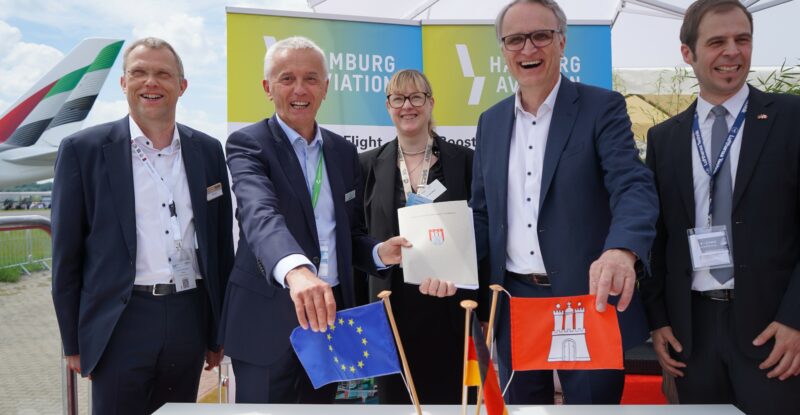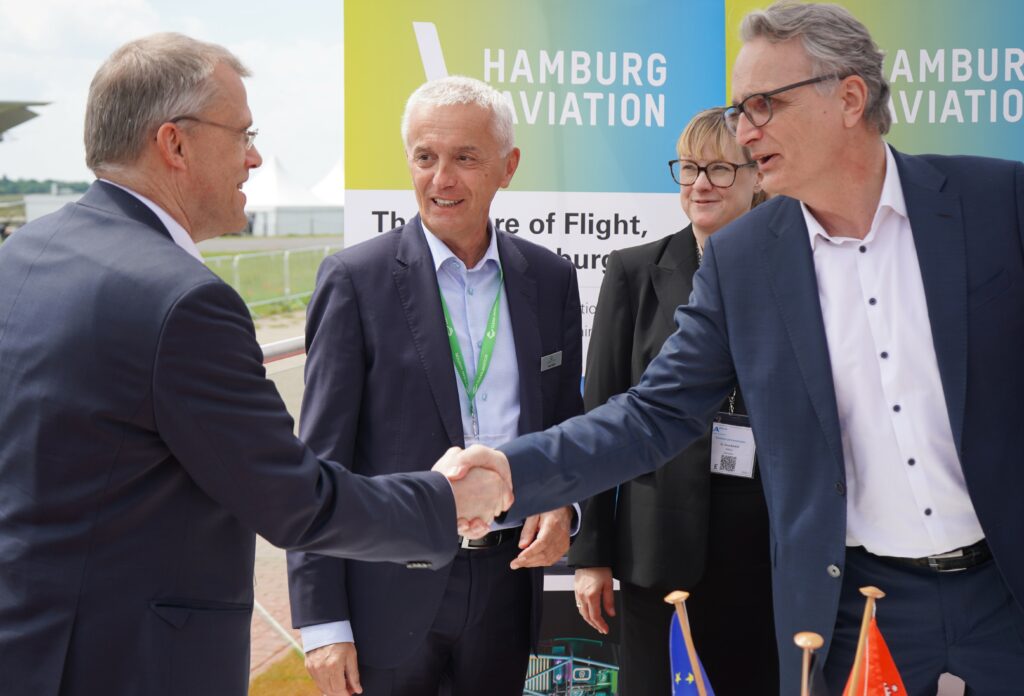 At the ILA Berlin International Air Show, the Clean Aviation Joint Undertaking and the City of Hamburg signed a Memorandum of Cooperation (MoC) to accelerate the demonstration of low-emission aircraft technologies and concepts for entry into airline service by 2035.
At the ILA Berlin International Air Show, the Clean Aviation Joint Undertaking and the City of Hamburg signed a Memorandum of Cooperation (MoC) to accelerate the demonstration of low-emission aircraft technologies and concepts for entry into airline service by 2035.
The parties have agreed on a joint strategic roadmap for Net-Zero aviation in line with the European Green Deal objectives, identifying the Research and Innovation areas on which Hamburg is expected to focus concentrate efforts. Between 2024 and 2027, the City of Hamburg will mobilise up to €128 million in investments to support projects at regional level, contributing to the Clean Aviation’s Strategic Research and Innovation Agenda (SRIA) and programme objectives.
Axel Krein, Executive Director of the Clean Aviation Joint Undertaking, said: “The Free & Hanseatic City of Hamburg is now a strategic and pivotal partner of the Clean Aviation Joint Undertaking whose remit it is to develop disruptive technologies for low-emission aircraft to enter in service by 2035. Our common goal to accelerate transformation towards sustainable aviation is achievable by pulling together the best available expertise and resources from across Europe, in recognition that no single region or country can accomplish this goal alone.”
“The City of Hamburg is very proud to join forces with the Clean Aviation Joint Undertaking. Our significant investments will play a crucial role in developing technologies for the next generation of low-emission aircraft powered by Sustainable Aviation Fuel or hydrogen. Furthermore, it will strengthen our regional aviation ecosystem, which is at the forefront of sustainability,” stated Andreas Rieckhof, the City of Hamburg’s State Council of the Ministry for Economic and Innovation.
“This is good news for Hamburg’s aviation community,” comments Ralf Gust, Managing Director of Hamburg Aviation, a dedicated cluster network supporting the aviation industry in Hamburg. “This initiative perfectly complements the intensive endeavours underway in the Hamburg region to transform aviation into a post-carbon industry, by aligning the many efforts of business, research and public policy in Hamburg with a European strategic roadmap. We are certain it will have a positive benefit for aviation in Hamburg and across Europe looking forward,” Gust continues.
Establishing cooperation on synergies with European regions is one of the key drivers of Horizon Europe, the EU research and innovation programme (2021-2027). Synergies between Clean Aviation and regional programmes are expected to deliver significant impacts, in particular in terms of:
- Increased number of low-emissions aircraft disruptive technologies and concepts;
- Increased competitiveness of regional aviation players, in particular SMEs;
- Creation of jobs and skills required for aviation transition towards climate-neutrality.
Since 2023, the Clean Aviation Joint Undertaking have signed three additional MoCs with regions, i.e., Occitanie (FR). Campania and Piemont (IT), leveraging on their commitments for net-zero aviation.
The Clean Aviation Joint Undertaking approach on synergies with European regions marks a step change in what was achieved under Clean Sky 2, whereby 18 Memoranda of Understanding (MoU) were signed with national or regional authorities, supporting over 50 pilot regional projects for cutting-edge technologies with a budget of over €50 million.
About Hamburg Aviation
With more than 40,000 highly qualified professionals, Hamburg Aviation is one of the largest sites for civil aviation worldwide. In addition to the two industry giants Airbus and Lufthansa Technik as well as Hamburg Airport, more than 300 suppliers and diverse technological and scientific institutions contribute to the cluster’s world-class expertise. To support and promote the cluster, enterprises, universities, associations, policy makers and other partners have joined forces to form Hamburg Aviation. Together, they pursue one goal: to bring high-quality products and services for the aviation of the future to the market through networked research and development, which are good for passengers and set standards in terms of resource protection. In 2008, Hamburg’s aviation cluster was named a top cluster by the Federal Ministry of Education and Research. Since 2014, Hamburg Aviation has been awarded the GOLD label as one of Europe’s best-managed clusters by the European Commission’s ECEI initiative. In 2016, the “Land of Ideas” initiative named the Hamburg Aviation network one of the “100 Excellent Places” in Germany.
About Clean Aviation
The Clean Aviation Joint Undertaking is the European Union’s leading research and innovation programme for transforming aviation towards a sustainable and climate-neutral future. It is a successful European public-private partnership between the European Commission through Horizon Europe, the EU research and innovation programme, and the European aeronautics industry. It has a budget of €4.1 billion divided into €1.7 billion in EU funding and no less than €2.4 billion in private funding. The programme’s disruptive clean aviation technologies will help reduce the emission footprint of short-medium range aircraft by no less than 30% and -50% for regional range aircraft compared to 2020 state-of-the-art aircraft. Clean Aviation builds on the knowledge and expertise of the Clean Sky programmes (2008-2024).
Clean Aviation is forging collaboration with the European Union Aviation Safety Agency (EASA) and synergies with other complementary partnerships, such as the Clean Hydrogen Partnership, and with other EU funding instruments (e.g. the European Regional Development Fund), as well as with national and regional innovation programmes.
All images credited to Hamburg Aviation








